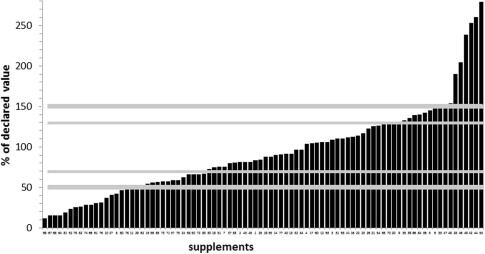Published in the journal Food Chemistry, the paper concluded that declared values for total selenium content often differed from actual content.
For 60 of the products (70%), the selenium content ranged from 50% to 150% of the declared value. Ten of the samples contained just 12–30% of that declared and another eight contained up to half of the amount claimed on pack.
In 21 of the products, the selenium content determined exceeded values declared by between 110% to 150% of the declared value. In eight cases this was significantly higher at 151–280%.
“[T]he label and information attached to the dietary supplement do not constitute a full or reliable source of information for consumers,” wrote the researchers from the Adam Mickiewicz University in Poland.

Neither Polish nor EU law obliges producers to provide information about the composition and form of compounds in their product. The study claimed to be the first to look at selenium supplements available on a member state market.
“Selenium is an essential mineral, too much or too little of which can have severe consequences for human health.”
Most of the preparation did not comply with recommended daily intake doses and only one producer declared the recommended daily dose on pack. Despite this the researchers said none of the supplements tested presented a danger of toxic doses.
How does EU compare to US?
They said low dietary levels of the essential mineral had been recorded in Poland in recent years, which could be due to low levels in European soil. Past research found that in some areas of Poland blood levels were as low as 50–55 microgram (μg)/L, while the calculated daily dietary intake is about 30–40 μg. This compares to the US, Japan, Canada and Venezuela where levels reached up to 300 μg per day.
“Dietary supplementation is one possible solution to providing this element,” they said.
Last year the European Food Safety Authority (EFSA) set an Adequate Intake (AI) of 70 microgram (µg) per day for adults, and an AI of 15 µg/day for infants aged 7-11 months. AIs ranged from 15 µg/day for children aged one to three years to 70 µg/day for adolescents aged 15-17 years. For breastfeeding women, 85 µg/day was set to account for the amount of selenium secreted in breast milk
Source: Food Chemistry
Vol. 190, pp 454–459, doi:10.1016/j.foodchem.2015.05.125
“Selenium species in selenium fortified dietary supplements”
Authors: P. Niedzielski, M. Rudnicka, M. Wachelka, L. Kozak, M. Rzany, M. Wozniak and Z. Kaskow
